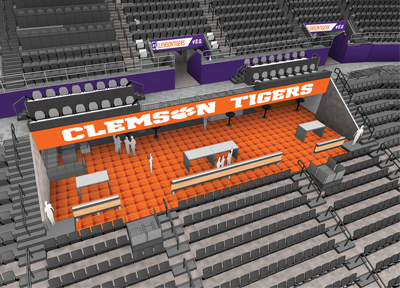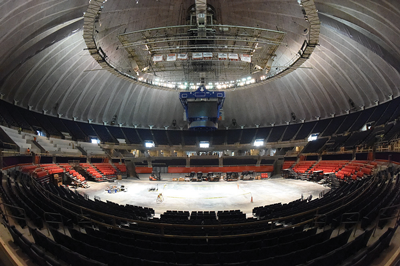Greg Brown specializes in designing college arenas. His current projects include major renovations to State Farm Center (University of Illinois) and Littlejohn Coliseum (Clemson University), plus a 3,500-seat arena for the New Jersey Institute of Technology, part of a multipurpose building doubling as a student recreation center. Overall, AECOM’s recent college work extends to The Pavilion at Ole Miss, a $65 million arena opening in January, upgrades to West Virginia’s coliseum, and DePaul University’s new $173 million arena planned for downtown Chicago. Brown recently spoke with SportsBusiness Journal facilities writer Don Muret.
What are the trends you see in college arena development? What are the schools asking for?
BROWN: In my mind, how a college arena seating bowl design differs from an NBA arena, is we like to start with the students. Take care of them first. The student section is the heartbeat, the soul of our game experience for all fans. Clemson’s new club seats are seven rows back from the court but we still have several rows of standing students in front of them. Students on the floor has become the standard. It’s the starting point. When we sit down with the coach, they don’t typically care a lot about the seating bowl, but the one question they’re going to ask you is “Where are my student sections?” So we like to start at that same exact place and work back.
What are the premium trends?
BROWN: At Illinois and Clemson, we still see club seats as the No. 1 demand. A nice seat, good spot, access to a
 |
| Brown |
special place somewhere. [The question is] can we get 50 club seats in this space or one suite? We work through the numbers with our clients. Typically, what we see is they can achieve greater ROI with club seats. What’s changed a little bit, and what we see evolving, is the variety and distribution of those seating locations. At State Farm Center, we have four clubs in three different locations. People sit where they want to sit [but] still want access to a club.
The other thing we’re seeing is putting suites and club openings down lower into the bowl and more integrated. The whole concept of sitting up in a [mid-level] box is not viable anymore. There is a stigma to it. At Illinois, there are 12 suites and the front two-thirds [of those spaces] are open-air, part of the seating bowl fabric. At Clemson, where we have a big club opening on the sideline, we pushed that down as far as we could. There is an 80-foot-wide opening for 400 people — only 60 feet from the court.
 |
Clemson’s renovated arena will feature a new club on the sideline that will be only 60 feet from the court.
Photo by: AECOM |
What about the idea of students-only clubs — spaces with a non-alcohol policy but a place for students to gather before the game and at halftime. Do you see that concept gaining traction?
BROWN: Yes. It gives them a place to stay warm, get organized and fired up during pregame. Then 30 minutes before tipoff, you get them out of there and the club can “flip” for a different special group or dining area.
Operationally, if you’re doing it right with a great student section, they’re in their seats for warmups, and in terms of fighting for real estate, you’re not sacrificing that much. Illinois will be doing it with the plan to turn it back over [for all fans]. You can drive improved fan experience and revenue, because students don’t need it during the game.
Ole Miss has a food court for students adjacent to the concourse. Similarly, when we were working with Clemson through design issues, we talked about a big zone on the concourse where we can bring students in and program activity for them before tip. Then it opens back up like it needs to function during the game.
For meeting the needs of sponsors, what are those schools’ partners asking for in terms of activation and how it can be incorporated into design?
BROWN: Every project is different. For some schools, it would be the last thing in the world to go down that naming-rights road, especially in existing buildings with history. It had to be navigated at Illinois, but I think they did a good job working through the State Farm deal and aligning expectations for how signs would be integrated in a [52-year-old] structure still eligible for listing on the National Register of Historic Places. We went through a few iterations with the university to determine what the signage would look like. It requires a lot of delicate communication.
What’s new in technology?
 |
An upgraded State Farm Center at Illinois will feature 12 suites.
Photo by: AECOM |
BROWN: We see our college clients one cycle behind the cutting-edge tech applications of our pro clients. But that lag time is shrinking. Right now, almost all we can do is make sure the infrastructure is there in terms of capacity and network. The harder part then, on the client side, is identifying the best way to use it, how they can leverage it to begin rolling out in-game apps, capturing big data, providing unique game-only features. They’re still playing catchup, but it’s coming.
Any other trends?
BROWN: If we can find ways to leverage investment in an arena to benefit the greater campus community, it ends up triggering additional support from other campus interests. One example is the new entry lobby at Clemson. It wasn’t picking up traction in terms of the way the client was receiving it, until we started to talk about it. It’s 8,000 square feet of space, high volume … one of the nicest assembly spaces on campus. It can be used for lectures, special events, etc. It’s about finding ways to go beyond the typical 40 event nights for men’s and women’s basketball to make it a greater asset for the university. That’s something we’re seeing a lot of interest in and something we’re very mindful of in our design work.”







